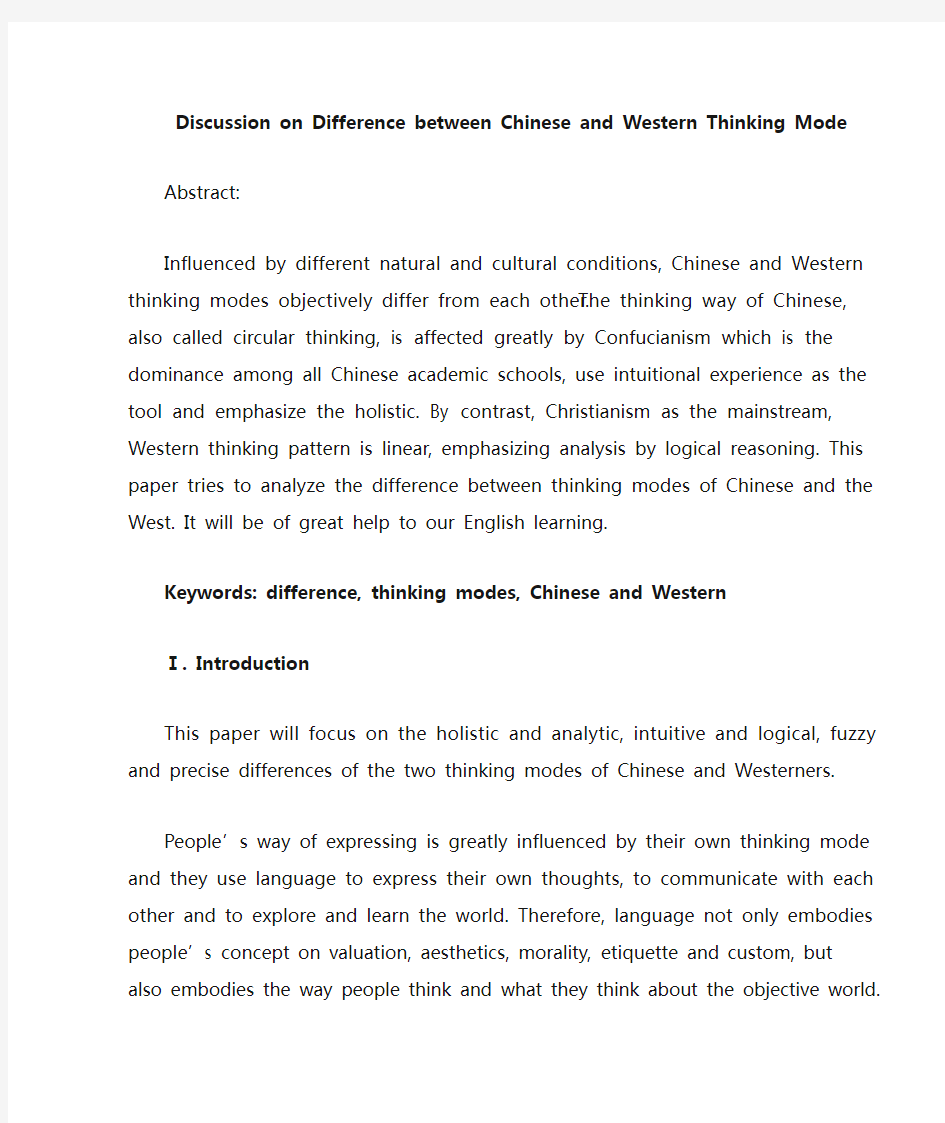中西思维模式对比

- 1、下载文档前请自行甄别文档内容的完整性,平台不提供额外的编辑、内容补充、找答案等附加服务。
- 2、"仅部分预览"的文档,不可在线预览部分如存在完整性等问题,可反馈申请退款(可完整预览的文档不适用该条件!)。
- 3、如文档侵犯您的权益,请联系客服反馈,我们会尽快为您处理(人工客服工作时间:9:00-18:30)。
Discussion on Difference between Chinese and Western
Thinking Mode
Abstract:
Influenced by different natural and cultural conditions, Chinese and Western thinking modes objectively differ from each other. The thinking way of Chinese, also called circular thinking, is affected greatly by Confucianism which is the dominance among all Chinese academic schools, use intuitional experience as the tool and emphasize the holistic. By contrast, Christianism as the mainstream, Western thinking pattern is linear, emphasizing analysis by logical reasoning. This paper tries to analyze the difference between thinking modes of Chinese and the West. It will be of great help to our English learning.
Keywords: difference, thinking modes, Chinese and Western
Ⅰ. Introduction
This paper will focus on the holistic and analytic, intuitive and logical, fuzzy and precise differences of the two thinking modes of Chinese and Westerners.
People’s way of expressing is greatly influenced by their own thinking mode and they use language to express their own thoughts, to communicate with each other and to explore and learn the world. Therefore, language not only embodies people’s concept on valuation, aesthetics, morality, etiquette and custom, but also embodies the way people think and what they think about the objective world. Different people have different thinking mode because of different environment, culture, custom and hereditary genes. And this kind of gap is more giant when it comes thinking modes of the whole Chinese and Westerners.
Thus, it is very important analyze the two different thinking modes deeply and completely, which will be of great help for students’ translation, writing, speech and even for all intercultural learning and communication.
This paper consists of 3 parts, respectively dealing with the holistic and analytic, intuitive and logical, and fuzzy and precise differences between Chinese and Western thinking modes.
Ⅱ. China “Holistic” and the West “Analytic”
In the basic intelligence operation, Chinese people prefer holistic comprehension while Westerners prefer analysis, resulting Chinese holistic priorities and Westerners’partial priority thinking. For example, in alphabetical order, in the Chinese surnames caste comes first, and then seniority, and the last are their names, highlighting the clan. But in Western countries, their own name comes first, and then the parent name, and then the family name, highlighting their own names. Another example: in the order of
writing time and address, the Chinese people are used to arrange year, month and day in decreasing order of sequence, and the address is arranged from provincial, city and county to house number sort, highlighting the precipitation of individual relationships, while the Westerners are in the opposite order, highlighting the synthesis of the individual.
Chinese people’s holistic and comprehensive thinking is also reflected in the traditional Chinese culture. For example, the traditional Chinese medicine theory proposes that the various organs are an organic whole, and use the Yinyang theory and the five-element doctrine to explain the interdependence between internal organs and mutual checks and balances. This is very different from Western medicine based on the body’s physical structure of nine systems to explain the pathological phenomena. From the concept, the Chinese medicine is the product of holistic thinking, while Western medicine is a product of analytical thinking. Another example is the Chinese art of painting. In the Chinese painting, there are not only pictures, but also poetry, calligraphy, seal carving and other various contents. But in western painting, there is no calligraphy.
In short, for Westerners, to clarify one thing, they must first split it and put things apart in order to analyze the internal structure. For Chinese, they take things as a whole, focus on the linkages with other things, and use experience dealing with other things to judge and speculate.
Ⅱ. China “Intuitive” and the West “Logical”
Imagery thinking refers to the psychological process of analyzing, synthesizing, processing and transforming memory image to form new image in the mind. It’s a special form of thinking, i.e. usual imagination. Thinking is famous in the world by virtue of intuitive wholeness and harmonious dialectic. Chinese people to a large extent depend on the intuition to work out natural secrets. Laotse considered the Tao which could be expressed was not invariable Tao. His views on “Tao” make people unable to understand. Such confused and stupefied “Tao”is also beyond comprehension as a kind of philosophy. We are not accustomed to explicitly defining the cognition of things through definitions. Laotse described “Tao” as “The Tao that can be told is not the eternal Tao.”“The morality, as a thing which can be felt in one’s heart, is just a transient mental image illuminating everything; for such transient mental image illuminating everything, people can observe its vivid image and experience its essence in their hearts.” The origin of Chinese culture is explained with “observation of astronomical phenomena to make tools”in the Book of Changes. Chinese characters are pictographs. Traditional Chinese medical science belongs to typical perceptual observation and experience judgment. During the Spring and Autumn, Four Diagnostic Methods (Inspection, olfaction, inquiry and palpation) invented by a famous doctor Bian Que belong to a theory of treating disease by experience. Chinese people usually rely greatly on the intuition, judge and measure a person by the intuition. This is also called “judge others by oneself”. Chinese people with concrete thinking are only content with summary of experience and description of phenomena in terms of cognition of things by traditional way of thinking
